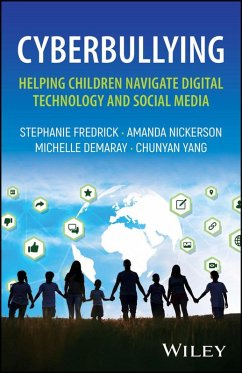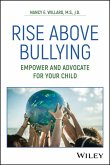Stephanie Fredrick, Amanda Nickerson, Michelle Demaray, Chunyan Yang
Cyberbullying: Helping Children Navigate Digital Technology and Social Media (eBook, ePUB)
24,99 €
24,99 €
inkl. MwSt.
Sofort per Download lieferbar

0 °P sammeln
24,99 €
Als Download kaufen

24,99 €
inkl. MwSt.
Sofort per Download lieferbar

0 °P sammeln
Jetzt verschenken
Alle Infos zum eBook verschenken
24,99 €
inkl. MwSt.
Sofort per Download lieferbar
Alle Infos zum eBook verschenken

0 °P sammeln
Stephanie Fredrick, Amanda Nickerson, Michelle Demaray, Chunyan Yang
Cyberbullying: Helping Children Navigate Digital Technology and Social Media (eBook, ePUB)
- Format: ePub
- Merkliste
- Auf die Merkliste
- Bewerten Bewerten
- Teilen
- Produkt teilen
- Produkterinnerung
- Produkterinnerung

Bitte loggen Sie sich zunächst in Ihr Kundenkonto ein oder registrieren Sie sich bei
bücher.de, um das eBook-Abo tolino select nutzen zu können.
Hier können Sie sich einloggen
Hier können Sie sich einloggen
Sie sind bereits eingeloggt. Klicken Sie auf 2. tolino select Abo, um fortzufahren.

Bitte loggen Sie sich zunächst in Ihr Kundenkonto ein oder registrieren Sie sich bei bücher.de, um das eBook-Abo tolino select nutzen zu können.
Cyberbullying: Helping Children Navigate Digital Technology and Social Media is a practical resource for addressing bullying and aggressive behaviors online. Authored by school psychologists, this book offers a balanced perspective on keeping kids safe online in ways that promote positive development. Finding accurate guidance for helping children navigate their digital world can be challenging. This resource counters misinformation and media-fueled negativity by presenting a thoughtful account of the dangers and benefits of digital technology and social media.
Key features include:
…mehr
- Geräte: eReader
- mit Kopierschutz
- eBook Hilfe
- Größe: 0.93MB
Andere Kunden interessierten sich auch für
![Cyberbullying: Helping Children Navigate Digital Technology and Social Media (eBook, PDF) Cyberbullying: Helping Children Navigate Digital Technology and Social Media (eBook, PDF)]() Stephanie FredrickCyberbullying: Helping Children Navigate Digital Technology and Social Media (eBook, PDF)24,99 €
Stephanie FredrickCyberbullying: Helping Children Navigate Digital Technology and Social Media (eBook, PDF)24,99 €![Rise Above Bullying (eBook, ePUB) Rise Above Bullying (eBook, ePUB)]() Nancy E. WillardRise Above Bullying (eBook, ePUB)24,99 €
Nancy E. WillardRise Above Bullying (eBook, ePUB)24,99 €![Bullying Interventions in Schools (eBook, ePUB) Bullying Interventions in Schools (eBook, ePUB)]() Ken RigbyBullying Interventions in Schools (eBook, ePUB)39,99 €
Ken RigbyBullying Interventions in Schools (eBook, ePUB)39,99 €![Rise Above Bullying (eBook, PDF) Rise Above Bullying (eBook, PDF)]() Nancy E. WillardRise Above Bullying (eBook, PDF)24,99 €
Nancy E. WillardRise Above Bullying (eBook, PDF)24,99 €![Restless Virgins (eBook, ePUB) Restless Virgins (eBook, ePUB)]() Abigail JonesRestless Virgins (eBook, ePUB)11,99 €
Abigail JonesRestless Virgins (eBook, ePUB)11,99 €![Big Kids, Bigger Feelings (eBook, ePUB) Big Kids, Bigger Feelings (eBook, ePUB)]() Alyssa Blask CampbellBig Kids, Bigger Feelings (eBook, ePUB)19,74 €
Alyssa Blask CampbellBig Kids, Bigger Feelings (eBook, ePUB)19,74 €![Teens Mental Health in the Social Media Era: Finding Balance in a Digital World (Health & Wellness) (eBook, ePUB) Teens Mental Health in the Social Media Era: Finding Balance in a Digital World (Health & Wellness) (eBook, ePUB)]() JileshTeens Mental Health in the Social Media Era: Finding Balance in a Digital World (Health & Wellness) (eBook, ePUB)5,49 €
JileshTeens Mental Health in the Social Media Era: Finding Balance in a Digital World (Health & Wellness) (eBook, ePUB)5,49 €-
-
-
Cyberbullying: Helping Children Navigate Digital Technology and Social Media is a practical resource for addressing bullying and aggressive behaviors online. Authored by school psychologists, this book offers a balanced perspective on keeping kids safe online in ways that promote positive development. Finding accurate guidance for helping children navigate their digital world can be challenging. This resource counters misinformation and media-fueled negativity by presenting a thoughtful account of the dangers and benefits of digital technology and social media.
Key features include:
This book's practical approach will be invaluable to families, educators, and anyone working with children who care about their well-being.
Key features include:
- Research-informed insights into youth social-emotional development including peer relationships, aggression, and bullying
- Evidence-based information and strategies to guide children on how to use technology responsibly and positively and communicate openly about cyberbullying
- Legal implications and international considerations for cyberbullying and related online aggressive behavior
This book's practical approach will be invaluable to families, educators, and anyone working with children who care about their well-being.
Dieser Download kann aus rechtlichen Gründen nur mit Rechnungsadresse in D ausgeliefert werden.
Produktdetails
- Produktdetails
- Verlag: John Wiley & Sons
- Seitenzahl: 331
- Erscheinungstermin: 5. März 2025
- Englisch
- ISBN-13: 9781394276790
- Artikelnr.: 73575996
- Verlag: John Wiley & Sons
- Seitenzahl: 331
- Erscheinungstermin: 5. März 2025
- Englisch
- ISBN-13: 9781394276790
- Artikelnr.: 73575996
- Herstellerkennzeichnung Die Herstellerinformationen sind derzeit nicht verfügbar.
Stephanie Fredrick, PhD, is an Associate Professor of School Psychology and Associate Director of the Alberti Center for Bullying Abuse Prevention at the University at Buffalo, the State University of New York. Her research investigates risk and protective factors for bullying and cyberbullying, youth digital media use, and school mental health. Dr. Fredrick is a licensed psychologist, a Nationally Certified School Psychologist, and associate editor of the Journal of School Psychology. She has written over 40 publications and book chapters and frequently partners with schools to consult on bullying and cyberbullying, digital media use, and youth mental health.
Amanda Nickerson, PhD, is a SUNY Distinguished Professor of School Psychology and Director of the Alberti Center for Bullying Abuse Prevention at the University at Buffalo, the State University of New York. Her research focuses on understanding, preventing, and intervening with crises, violence, bullying, and abuse, as well as building social-emotional strengths and supports for youth. She has written over 130 publications and conducted over 350 presentations at professional conferences and to school and community groups. She is a licensed psychologist, Nationally Certified School Psychologist, and fellow of the American Psychological Association.
Michelle Demaray, PhD, is a Northern Illinois University Board of Trustees and Presidential Research Professor. She is a Licensed Clinical Psychologist and Certified School Psychologist. Dr. Demaray was the prior editor of the Journal of School Psychology and is a fellow of the American Psychological Association. Her research is focused on bullying and victimization and social support. She has written 90 publications and conducted 200 presentations at professional conferences. She co-authored a Tier 2 intervention for youth at risk of social emotional difficulties. She has been a Project Director or Co-Director on training and research grants totaling over 10 million dollars.
Chunyan Yang, PhD, is an Associate Professor of School Psychology in Department of Counseling, Higher Education, and Special Education at the University of Maryland, College Park. Her research explores how school community members interact with their ecological contexts to build resilience against risks like bullying, cyberbullying, problematic internet use, teacher-targeted violence, and mental health challenges. She has published over 80 scholarly works and given more than 100 presentations at national and international conferences. She is a Nationally Certified School Psychologist, an associate editor of School Psychology Review and a Research Fellow of the Jacobs Foundation.
Amanda Nickerson, PhD, is a SUNY Distinguished Professor of School Psychology and Director of the Alberti Center for Bullying Abuse Prevention at the University at Buffalo, the State University of New York. Her research focuses on understanding, preventing, and intervening with crises, violence, bullying, and abuse, as well as building social-emotional strengths and supports for youth. She has written over 130 publications and conducted over 350 presentations at professional conferences and to school and community groups. She is a licensed psychologist, Nationally Certified School Psychologist, and fellow of the American Psychological Association.
Michelle Demaray, PhD, is a Northern Illinois University Board of Trustees and Presidential Research Professor. She is a Licensed Clinical Psychologist and Certified School Psychologist. Dr. Demaray was the prior editor of the Journal of School Psychology and is a fellow of the American Psychological Association. Her research is focused on bullying and victimization and social support. She has written 90 publications and conducted 200 presentations at professional conferences. She co-authored a Tier 2 intervention for youth at risk of social emotional difficulties. She has been a Project Director or Co-Director on training and research grants totaling over 10 million dollars.
Chunyan Yang, PhD, is an Associate Professor of School Psychology in Department of Counseling, Higher Education, and Special Education at the University of Maryland, College Park. Her research explores how school community members interact with their ecological contexts to build resilience against risks like bullying, cyberbullying, problematic internet use, teacher-targeted violence, and mental health challenges. She has published over 80 scholarly works and given more than 100 presentations at national and international conferences. She is a Nationally Certified School Psychologist, an associate editor of School Psychology Review and a Research Fellow of the Jacobs Foundation.
Preface ix
Acknowledgments xi
1 Peer Relationships and Bullying Over the Years 1
Peer Relationships in Infancy, Toddlerhood, and Early Childhood 2
Peer Relationships in Middle and Late Childhood 4
Peer Relationships in Adolescence 5
Role of Digital Technology in Peer Relationships 8
Bullying and Cyberbullying 11
References 15
2 Digital Media Use: The Early Years 23
What Is Digital Media and Technology? 24
Evolution of Digital Media and Technology 24
Digital Media Use from Infancy to Childhood 28
Research Methods and Terminology 32
Effects of Digital Media Use on Child Development 34
Parent Media Practices and Joint Media Engagement 36
Summary 39
References 40
3 Digital Media Use: The Preteen and Teenage Years 45
Digital Media Use Among Preteens and Teens 45
Smartphone Use 48
Effects of Digital Media Use 49
Digital Media Use and Youth Mental Health 50
Digital Media Use and Youth Physical Health 54
Digital Media Use and Youth Academic Performance 56
Benefits of Digital Media Use 58
Summary 59
References 60
4 Cyberbullying and Other Forms of Cyber Aggression 67
Impact of Cyberbullying 73
Why Do Youth Engage in Cyberbullying? 75
Risk and Protective Factors 79
Risk and Protective Factors for Being Cyberbullied 81
Risk and Protective Factors for Cyberbullying Others 84
Digital Self-Harm 85
References 88
5 Helping Children Navigate Social and Digital Life 95
Supporting Social-Emotional Competencies and Building Positive Peer
Relationships 95
Promoting Safe Media Use 99
Model Responsible Behavior on Social Media 99
Promote Healthy Online Use 100
Talk About Online Lives 100
Co-use Media 101
Engage in Active Mediation 102
Support Youth to Engage in Bystander Intervention in Online Spaces 104
Set Limits 105
Deciding If and When to Give a Child a Smartphone 106
Setting Rules About Digital Technology Use 107
Monitor Use 109
Resources for Parents and Educators 110
References 112
6 Families Role in Recognizing and Responding to Problematic Online
Behaviors 117
Warning Signs 118
Responding to Cyberbullying Involvement 123
Responding to Problematic Social Media Use and Gaming 126
Outside Interventions for Problematic Online Behavior 128
Responding to Digital Self-Harm 130
Summary 130
References 131
7 Schools' Role in Preventing Cyberbullying and Other Forms of Cyber
Aggression 135
The Importance of Schools and Family Involvement in Cyberbullying
Prevention 136
What Is a Multi-tiered Support System? 137
Social and Emotional Learning and School-wide Digital Citizenship Programs
138
Positive Behavior Intervention Support 147
School-wide and Classroom-wide Mindfulness Programs 150
Restorative Justice Approaches 151
Trauma-Informed Programs 152
Summary 153
References 154
8 School-Family Partnership 159
Communicating with the School 159
Whom Should I Contact at the School If My Child Is Being Cyberbullied? 160
What Information Should I Share? 161
What Should I Expect from the School? 163
The Bullying Is Still Happening: How Can I Best Advocate for My Child? 165
How Can I Work with the School If My Child Is Cyberbullying Others? 167
How Can I Work with the School If My Child Is a Bystander of Cyberbullying?
168
How Educators Can Best Partner with Families? 169
Engage in Effective Two-Way Communication 169
Focus on Shared Decision-Making 171
References 174
9 Legal Implications: Problematic Online Behavior and the Law 179
Federal Laws for Harassment 179
State Laws and School District Policies for Cyberbullying 181
Civil Law Regarding Cyberbullying 183
Davis v. Monroe County Board of Education (1999) 184
J.S. v. Bethlehem Area School District (2002) 184
Tinker v. Des Moines Independent School District (1969) 184
When Should School Districts Intervene? 185
Criminal Cyberbullying Behaviors 186
Sexting 187
Legal Implications of Sexting 188
Responding to Sexting 189
Online Predators 190
Summary 191
References 192
10 International Efforts to Address Cyberbullying and Other Forms of Cyber
Aggression 195
Global Trends of Cyberbullying 195
International Digital Citizenship and Parenting Practices 196
Laws and Policies on Internet and Device Use Across the Globe 199
DCE Across the Globe 199
DCE in Europe 200
DCE in Asia and the Global South 204
Summary 209
References 209
Subject Index 215
Acknowledgments xi
1 Peer Relationships and Bullying Over the Years 1
Peer Relationships in Infancy, Toddlerhood, and Early Childhood 2
Peer Relationships in Middle and Late Childhood 4
Peer Relationships in Adolescence 5
Role of Digital Technology in Peer Relationships 8
Bullying and Cyberbullying 11
References 15
2 Digital Media Use: The Early Years 23
What Is Digital Media and Technology? 24
Evolution of Digital Media and Technology 24
Digital Media Use from Infancy to Childhood 28
Research Methods and Terminology 32
Effects of Digital Media Use on Child Development 34
Parent Media Practices and Joint Media Engagement 36
Summary 39
References 40
3 Digital Media Use: The Preteen and Teenage Years 45
Digital Media Use Among Preteens and Teens 45
Smartphone Use 48
Effects of Digital Media Use 49
Digital Media Use and Youth Mental Health 50
Digital Media Use and Youth Physical Health 54
Digital Media Use and Youth Academic Performance 56
Benefits of Digital Media Use 58
Summary 59
References 60
4 Cyberbullying and Other Forms of Cyber Aggression 67
Impact of Cyberbullying 73
Why Do Youth Engage in Cyberbullying? 75
Risk and Protective Factors 79
Risk and Protective Factors for Being Cyberbullied 81
Risk and Protective Factors for Cyberbullying Others 84
Digital Self-Harm 85
References 88
5 Helping Children Navigate Social and Digital Life 95
Supporting Social-Emotional Competencies and Building Positive Peer
Relationships 95
Promoting Safe Media Use 99
Model Responsible Behavior on Social Media 99
Promote Healthy Online Use 100
Talk About Online Lives 100
Co-use Media 101
Engage in Active Mediation 102
Support Youth to Engage in Bystander Intervention in Online Spaces 104
Set Limits 105
Deciding If and When to Give a Child a Smartphone 106
Setting Rules About Digital Technology Use 107
Monitor Use 109
Resources for Parents and Educators 110
References 112
6 Families Role in Recognizing and Responding to Problematic Online
Behaviors 117
Warning Signs 118
Responding to Cyberbullying Involvement 123
Responding to Problematic Social Media Use and Gaming 126
Outside Interventions for Problematic Online Behavior 128
Responding to Digital Self-Harm 130
Summary 130
References 131
7 Schools' Role in Preventing Cyberbullying and Other Forms of Cyber
Aggression 135
The Importance of Schools and Family Involvement in Cyberbullying
Prevention 136
What Is a Multi-tiered Support System? 137
Social and Emotional Learning and School-wide Digital Citizenship Programs
138
Positive Behavior Intervention Support 147
School-wide and Classroom-wide Mindfulness Programs 150
Restorative Justice Approaches 151
Trauma-Informed Programs 152
Summary 153
References 154
8 School-Family Partnership 159
Communicating with the School 159
Whom Should I Contact at the School If My Child Is Being Cyberbullied? 160
What Information Should I Share? 161
What Should I Expect from the School? 163
The Bullying Is Still Happening: How Can I Best Advocate for My Child? 165
How Can I Work with the School If My Child Is Cyberbullying Others? 167
How Can I Work with the School If My Child Is a Bystander of Cyberbullying?
168
How Educators Can Best Partner with Families? 169
Engage in Effective Two-Way Communication 169
Focus on Shared Decision-Making 171
References 174
9 Legal Implications: Problematic Online Behavior and the Law 179
Federal Laws for Harassment 179
State Laws and School District Policies for Cyberbullying 181
Civil Law Regarding Cyberbullying 183
Davis v. Monroe County Board of Education (1999) 184
J.S. v. Bethlehem Area School District (2002) 184
Tinker v. Des Moines Independent School District (1969) 184
When Should School Districts Intervene? 185
Criminal Cyberbullying Behaviors 186
Sexting 187
Legal Implications of Sexting 188
Responding to Sexting 189
Online Predators 190
Summary 191
References 192
10 International Efforts to Address Cyberbullying and Other Forms of Cyber
Aggression 195
Global Trends of Cyberbullying 195
International Digital Citizenship and Parenting Practices 196
Laws and Policies on Internet and Device Use Across the Globe 199
DCE Across the Globe 199
DCE in Europe 200
DCE in Asia and the Global South 204
Summary 209
References 209
Subject Index 215
Preface ix
Acknowledgments xi
1 Peer Relationships and Bullying Over the Years 1
Peer Relationships in Infancy, Toddlerhood, and Early Childhood 2
Peer Relationships in Middle and Late Childhood 4
Peer Relationships in Adolescence 5
Role of Digital Technology in Peer Relationships 8
Bullying and Cyberbullying 11
References 15
2 Digital Media Use: The Early Years 23
What Is Digital Media and Technology? 24
Evolution of Digital Media and Technology 24
Digital Media Use from Infancy to Childhood 28
Research Methods and Terminology 32
Effects of Digital Media Use on Child Development 34
Parent Media Practices and Joint Media Engagement 36
Summary 39
References 40
3 Digital Media Use: The Preteen and Teenage Years 45
Digital Media Use Among Preteens and Teens 45
Smartphone Use 48
Effects of Digital Media Use 49
Digital Media Use and Youth Mental Health 50
Digital Media Use and Youth Physical Health 54
Digital Media Use and Youth Academic Performance 56
Benefits of Digital Media Use 58
Summary 59
References 60
4 Cyberbullying and Other Forms of Cyber Aggression 67
Impact of Cyberbullying 73
Why Do Youth Engage in Cyberbullying? 75
Risk and Protective Factors 79
Risk and Protective Factors for Being Cyberbullied 81
Risk and Protective Factors for Cyberbullying Others 84
Digital Self-Harm 85
References 88
5 Helping Children Navigate Social and Digital Life 95
Supporting Social-Emotional Competencies and Building Positive Peer
Relationships 95
Promoting Safe Media Use 99
Model Responsible Behavior on Social Media 99
Promote Healthy Online Use 100
Talk About Online Lives 100
Co-use Media 101
Engage in Active Mediation 102
Support Youth to Engage in Bystander Intervention in Online Spaces 104
Set Limits 105
Deciding If and When to Give a Child a Smartphone 106
Setting Rules About Digital Technology Use 107
Monitor Use 109
Resources for Parents and Educators 110
References 112
6 Families Role in Recognizing and Responding to Problematic Online
Behaviors 117
Warning Signs 118
Responding to Cyberbullying Involvement 123
Responding to Problematic Social Media Use and Gaming 126
Outside Interventions for Problematic Online Behavior 128
Responding to Digital Self-Harm 130
Summary 130
References 131
7 Schools' Role in Preventing Cyberbullying and Other Forms of Cyber
Aggression 135
The Importance of Schools and Family Involvement in Cyberbullying
Prevention 136
What Is a Multi-tiered Support System? 137
Social and Emotional Learning and School-wide Digital Citizenship Programs
138
Positive Behavior Intervention Support 147
School-wide and Classroom-wide Mindfulness Programs 150
Restorative Justice Approaches 151
Trauma-Informed Programs 152
Summary 153
References 154
8 School-Family Partnership 159
Communicating with the School 159
Whom Should I Contact at the School If My Child Is Being Cyberbullied? 160
What Information Should I Share? 161
What Should I Expect from the School? 163
The Bullying Is Still Happening: How Can I Best Advocate for My Child? 165
How Can I Work with the School If My Child Is Cyberbullying Others? 167
How Can I Work with the School If My Child Is a Bystander of Cyberbullying?
168
How Educators Can Best Partner with Families? 169
Engage in Effective Two-Way Communication 169
Focus on Shared Decision-Making 171
References 174
9 Legal Implications: Problematic Online Behavior and the Law 179
Federal Laws for Harassment 179
State Laws and School District Policies for Cyberbullying 181
Civil Law Regarding Cyberbullying 183
Davis v. Monroe County Board of Education (1999) 184
J.S. v. Bethlehem Area School District (2002) 184
Tinker v. Des Moines Independent School District (1969) 184
When Should School Districts Intervene? 185
Criminal Cyberbullying Behaviors 186
Sexting 187
Legal Implications of Sexting 188
Responding to Sexting 189
Online Predators 190
Summary 191
References 192
10 International Efforts to Address Cyberbullying and Other Forms of Cyber
Aggression 195
Global Trends of Cyberbullying 195
International Digital Citizenship and Parenting Practices 196
Laws and Policies on Internet and Device Use Across the Globe 199
DCE Across the Globe 199
DCE in Europe 200
DCE in Asia and the Global South 204
Summary 209
References 209
Subject Index 215
Acknowledgments xi
1 Peer Relationships and Bullying Over the Years 1
Peer Relationships in Infancy, Toddlerhood, and Early Childhood 2
Peer Relationships in Middle and Late Childhood 4
Peer Relationships in Adolescence 5
Role of Digital Technology in Peer Relationships 8
Bullying and Cyberbullying 11
References 15
2 Digital Media Use: The Early Years 23
What Is Digital Media and Technology? 24
Evolution of Digital Media and Technology 24
Digital Media Use from Infancy to Childhood 28
Research Methods and Terminology 32
Effects of Digital Media Use on Child Development 34
Parent Media Practices and Joint Media Engagement 36
Summary 39
References 40
3 Digital Media Use: The Preteen and Teenage Years 45
Digital Media Use Among Preteens and Teens 45
Smartphone Use 48
Effects of Digital Media Use 49
Digital Media Use and Youth Mental Health 50
Digital Media Use and Youth Physical Health 54
Digital Media Use and Youth Academic Performance 56
Benefits of Digital Media Use 58
Summary 59
References 60
4 Cyberbullying and Other Forms of Cyber Aggression 67
Impact of Cyberbullying 73
Why Do Youth Engage in Cyberbullying? 75
Risk and Protective Factors 79
Risk and Protective Factors for Being Cyberbullied 81
Risk and Protective Factors for Cyberbullying Others 84
Digital Self-Harm 85
References 88
5 Helping Children Navigate Social and Digital Life 95
Supporting Social-Emotional Competencies and Building Positive Peer
Relationships 95
Promoting Safe Media Use 99
Model Responsible Behavior on Social Media 99
Promote Healthy Online Use 100
Talk About Online Lives 100
Co-use Media 101
Engage in Active Mediation 102
Support Youth to Engage in Bystander Intervention in Online Spaces 104
Set Limits 105
Deciding If and When to Give a Child a Smartphone 106
Setting Rules About Digital Technology Use 107
Monitor Use 109
Resources for Parents and Educators 110
References 112
6 Families Role in Recognizing and Responding to Problematic Online
Behaviors 117
Warning Signs 118
Responding to Cyberbullying Involvement 123
Responding to Problematic Social Media Use and Gaming 126
Outside Interventions for Problematic Online Behavior 128
Responding to Digital Self-Harm 130
Summary 130
References 131
7 Schools' Role in Preventing Cyberbullying and Other Forms of Cyber
Aggression 135
The Importance of Schools and Family Involvement in Cyberbullying
Prevention 136
What Is a Multi-tiered Support System? 137
Social and Emotional Learning and School-wide Digital Citizenship Programs
138
Positive Behavior Intervention Support 147
School-wide and Classroom-wide Mindfulness Programs 150
Restorative Justice Approaches 151
Trauma-Informed Programs 152
Summary 153
References 154
8 School-Family Partnership 159
Communicating with the School 159
Whom Should I Contact at the School If My Child Is Being Cyberbullied? 160
What Information Should I Share? 161
What Should I Expect from the School? 163
The Bullying Is Still Happening: How Can I Best Advocate for My Child? 165
How Can I Work with the School If My Child Is Cyberbullying Others? 167
How Can I Work with the School If My Child Is a Bystander of Cyberbullying?
168
How Educators Can Best Partner with Families? 169
Engage in Effective Two-Way Communication 169
Focus on Shared Decision-Making 171
References 174
9 Legal Implications: Problematic Online Behavior and the Law 179
Federal Laws for Harassment 179
State Laws and School District Policies for Cyberbullying 181
Civil Law Regarding Cyberbullying 183
Davis v. Monroe County Board of Education (1999) 184
J.S. v. Bethlehem Area School District (2002) 184
Tinker v. Des Moines Independent School District (1969) 184
When Should School Districts Intervene? 185
Criminal Cyberbullying Behaviors 186
Sexting 187
Legal Implications of Sexting 188
Responding to Sexting 189
Online Predators 190
Summary 191
References 192
10 International Efforts to Address Cyberbullying and Other Forms of Cyber
Aggression 195
Global Trends of Cyberbullying 195
International Digital Citizenship and Parenting Practices 196
Laws and Policies on Internet and Device Use Across the Globe 199
DCE Across the Globe 199
DCE in Europe 200
DCE in Asia and the Global South 204
Summary 209
References 209
Subject Index 215







